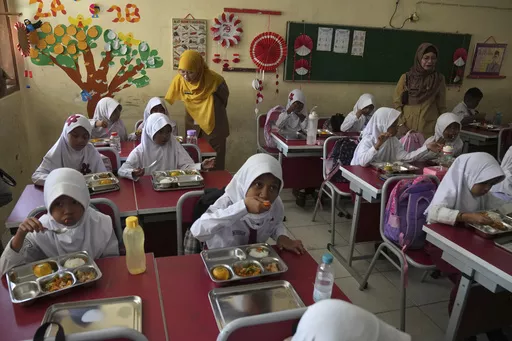Indonesia’s government launched an ambitious $28 million initiative on Monday to address malnutrition and stunting, targeting nearly 90 million children and pregnant women. However, the plan has faced criticism over its affordability and the logistical challenges it presents.
The Free Nutritious Meal program, introduced by President Prabowo Subianto, fulfills a key campaign promise made during his election last year. With a population exceeding 282 million, Indonesia is Southeast Asia’s largest economy. The program is designed to combat the stunting crisis that affects 21.5% of children under the age of five. It also seeks to boost the livelihoods of farmers by increasing the value of their harvests.
In his inaugural address in October, Subianto emphasized the widespread malnutrition among Indonesian children. He pledged to provide free school lunches and milk to 83 million students across more than 400,000 schools nationwide, as part of a broader vision to create a “Golden Indonesia” generation by 2045.
“Too many of our brothers and sisters are below the poverty line, too many of our children go to school without breakfast and lack basic school supplies,” Subianto said during his speech.
The Free Nutritious Meal program, which includes free milk distribution, is estimated to cost more than 450 trillion rupiah (approximately $28 billion). Despite concerns, Subianto has assured the public that the government has carefully planned the initiative. “We are capable,” he affirmed.
The government aims to reach 19.47 million schoolchildren and pregnant women by 2025, with an allocation of 71 trillion rupiah ($4.3 billion). The budget is designed to keep Indonesia’s annual deficit within a legislated 3% GDP ceiling, according to Dadan Hindayana, head of the newly established National Nutrition Agency.
Hindayana outlined the logistics of the program, which will supply approximately 6.7 million tons of rice, 1.2 million tons of chicken, 500,000 tons of beef, 1 million tons of fish, vegetables, and fruit, as well as 4 million kiloliters of milk. The government also plans to build at least 5,000 meal kitchens across the country.
The program began on Monday with a truck delivering 3,000 meal portions to SD Cilangkap 08, a primary school in Depok, a satellite city of Jakarta. The 740 students were served a meal consisting of rice, stir-fried vegetables, tempeh, chicken, and oranges.
“We send a team to each school to facilitate the meal distribution every day,” Hindayana said. Each student, from early childhood education to senior high school, will receive one meal per day, covering one-third of their daily caloric needs. These meals will be provided free of charge.
However, the program has sparked concerns among investors and analysts. Critics argue that the sheer scale of the initiative could place a heavy burden on Indonesia’s finances. They warn that the government may struggle to meet its fiscal goals while maintaining such an expansive program.
Nailul Huda, an economic researcher from the Center for Economic and Law Studies, questioned whether Indonesia’s current fiscal condition could support such a large financial commitment. He suggested that the program could exacerbate state debt and undermine economic growth targets.
Huda argued that the program might not achieve its intended outcomes, noting that misallocation of resources could undermine the benefits of the initiative. He also warned that it could strain Indonesia’s external balance of payments, given the country’s reliance on imports for essential goods like rice, wheat, soybeans, and dairy products.
Despite the criticism, some experts highlight the urgent need for action. Reni Suwarso, director of the Institute for Democracy, Security, and Strategic Studies, noted that Indonesia’s stunting rate remains far from the target of a 14% reduction by 2024.
According to the 2023 Indonesian Health Survey, 21.5% of the nation’s children are affected by stunting, a slight improvement of 0.8% from the previous year. The United Nations Children’s Fund (UNICEF) has also reported that one in 12 children under five in Indonesia are “wasted” (suffering from low weight for height), while one in five are stunted.
“That’s a severe problem that must be addressed urgently,” Suwarso said. “Child malnutrition has serious long-term consequences, impacting both health and future development.”
As Indonesia grapples with the twin challenges of malnutrition and financial sustainability, the success or failure of this program will likely have a profound impact on the country’s future development.


